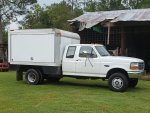I used mine on my trip from Austin, TX to the American Prairie Reserve near Malta, MT and back. I did not download any maps as it came the day I was leaving. I got one camera installed (still have 3 more to install). I ran it alongside of Google Maps, I constantly flipped between the Drive mode (standard road GPS) and the Explore mode (supposedly their off-road mode). In the drive mode, compare to Google Maps, the Overlander was more accurate on speed limits, the nice feature on the Overlander is it would indicate before a speed limit was changing. Entering the same address Google maps always took me on a quicker route than the Overlander. Where the Overlander excelled over Google maps was the what's up ahead feature on the Overlander. It allowed me to plan Gas stops up to 150 miles away, the integration with iOverlander in this feature made quick work in finding a place to sleep/stay for the night while on the road, being able to add that spot as a stop in the trip with just a button push made it effortless. Where google maps was better was more accurate GPS positioning, the Overlander was always a little behind in where it thought I was. Google maps also re-routed much quicker and more effective when I went off the suggested route. Google maps did majorly fail me by taking me on a track, rather than a dirt road that was supposed to take me an hour to get to my end spot, that ended up taking me 4 hours as I got stuck in the mud a lot. In talking with some folks, APR has asked Google to change this route, and Google has refused, if I would of followed the Overlander, I would of been there a lot sooner and not have me, my truck and my trailer completely covered in mud. Thank God I had maxtrax with me, otherwise I'd probably still be stuck.
The Explore mode was great in that it knows the difference between private and public land, it even shows driveways on private land. It was essential in letting me know if I was on APR's land or private land, where public lands started and stopped and 95% of dirt roads, tracks and paved roads. This became essential in deciding to take a track or not, because I could tell how long it was, if it connected with other tracks and where it actually lead. It also indicated somewhat the terrain and what it crossed. The explore mode was very accurate to water, included creeks, rivers, ponds. This came in really handy when I got stuck in the mud, because I could lay a path around the most probable spots of mud due to creeks crossing the track/trail. The Explore mode also was great in letting me to manually find routes to places I wanted to go. You can switch between drive mode and explore mode continually and drive mode keeps reporting if you inputted a route and transfers it to the explore mode.
The quality of the wireless camera is not great, it's very basic, low resolution and not good in low light conditions, all the cameras are configured to be backups cameras, so when used differently it's not the best configuration, but it is better than nothing, I have the one I have installed on my front license plate and pointed down so I can see what I'm driving over.
The one feature that I found useless was inputting the length of my truck with the trailer attached, the only thing I got out of it was a constant message of unknown if the road/track/trail was good for a vehicle with a trailer.
While I know this isn't an exhaustive review or even close to it, I thought I'd share my first experience using it.

